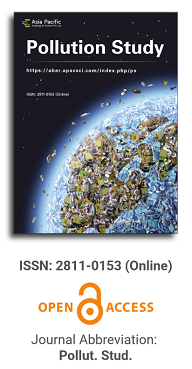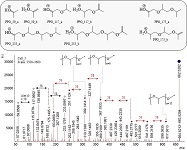
Asia Pacific Academy of Science Pte. Ltd. (APACSCI) specializes in international journal publishing. APACSCI adopts the open access publishing model and provides an important communication bridge for academic groups whose interest fields include engineering, technology, medicine, computer, mathematics, agriculture and forestry, and environment.

The (partial) replacement of synthetic polymers with bioplastics is due to increased production of conventional packaging plastics causing for severe environmental pollution with plastics waste. The bioplastics, however, represent complex mixtures of known and unknown (bio)polymers, fillers, plasticizers, stabilizers, flame retardant, pigments, antioxidants, hydrophobic polymers such as poly(lactic acid), polyethylene, polyesters, glycol, or poly(butylene succinate), and little is known of their chemical safety for both the environment and the human health. Polymerization reactions of bioplastics can produce no intentionally added chemicals to the bulk material, which could be toxic, as well. When polymers are used to food packing, then the latter chemicals could also migrate from the polymer to food. This fact compromises the safety for consumers, as well. The scarce data on chemical safety of bioplastics makes a gap in knowledge of their toxicity to humans and environment. Thus, development of exact analytical protocols for determining chemicals of bioplastics in environmental and food samples as well as packing polymers can only provide warrant for reliable conclusive evidence of their safety for both the human health and the environment. The task is compulsory according to legislation Directives valid to environmental protection, food control, and assessment of the risk to human health. The quantitative and structural determination of analytes is primary research task of analysis of polymers. The methods of mass spectrometry are fruitfully used for these purposes. Methodological development of exact analytical mass spectrometric tools for reliable structural analysis of bioplastics only guarantees their safety, efficacy, and quality to both humans and environment. This study, first, highlights innovative stochastic dynamics equations processing exactly mass spectrometric measurands and, thus, producing exact analyte quantification and 3D molecular and electronic structural analyses. There are determined synthetic polymers such as poly(ethylenglycol), poly(propylene glycol), and polyisoprene as well as biopolymers in bags for foodstuffs made from renewable cellulose and starch, and containing, in total within the 20,416–17,495 chemicals per sample of the composite biopolymers. Advantages of complementary employment in mass spectrometric methods and Fourier transform infrared spectroscopy is highlighted. The study utilizes ultra-high resolution electrospray ionization mass spectrometric and Fourier transform infrared spectroscopic data on biodegradable plastics bags for foodstuffs; high accuracy quantum chemical static methods, molecular dynamics; and chemometrics. There is achieved method performance |r| = 0.99981 determining poly(propylene glycol) in bag for foodstuff containing 20,416 species and using stochastic dynamics mass spectrometric formulas. The results highlight their great capability and applicability to the analytical science as well as relevance to both the fundamental research and to the industry.
Analyzing the relationship between air pollution and asthma outpatient visits in Hefei through time series data
Vol 3, Issue 1, 2022
Download PDF
Abstract
Objective: To examine the correlation between the volume of adult asthma patients seeking outpatient care and air pollution levels at a hospital in Hefei. Methods: Data on the number of asthma outpatients at a Hefei hospital from 2014 to 2020 were gathered, along with corresponding air pollution and meteorological data for the same timeframe. The R statistical software was employed to construct a generalized additive model to assess the lagged effects of air pollution on asthma outpatient numbers. Results: The hospital recorded a total of 7220 asthma outpatients during the study period, with 3104 males and 4116 females, 3798 in the warm season and 3422 in the cold season. The single pollutant model revealed that a 10% increase in SO2 concentration μg/m3 was associated with a 0.74% increase in asthma risk, with the strongest effect observed at lag2. NO2 was found to increase asthma risk by 0.31%, with the most significant impact at lag0. The two-pollutant model indicated that the effect of SO2 combined with NO2 diminished when SO2 was also combined with CO, O3, PM10, and PM2, with an increased post-5 lag effect. Conversely, the effect of NO2 combined with SO2 decreased when NO2 was also combined with CO, PM10, and PM2, with an increased post-5 lag effect. Stratified analysis by season showed that NO2's impact on asthma was greatest at lag0 during the cold season, while SO2's effect was more pronounced in the cold season than in the warm season, with the highest impact at lag2. Gender stratification analysis revealed that the effects of SO2 and NO2 were greater in men than in women. Conclusion: Between 2014 and 2020, an increase in SO2 and NO2 concentrations in Hefei was positively associated with the risk of asthma among outpatients at the hospital, with a noticeable lag effect. This finding underscores the importance of developing targeted preventive strategies to mitigate asthma occurrences and exacerbations.
Keywords
References
- Sesé L, Jeny F, Uzunhan Y, et al. The Effect of Air Pollution in Diffuse Interstitial Lung Disease (French). Revue des Maladies Respiratoires. 2020; 37(5): 389-398. doi: 10.1016/j.rmr.2020.02.015
- The Lancet. Air pollution: a major threat to lung health. Lancet. 2019; 393(10183): 1774.
- Wu TJ, Chen CH, Chen BY, et al. Ambient air pollution and asthma onset in Taiwanese adults. Respiratory Medicine. 2020; 172: 106133. doi: 10.1016/j.rmed.2020.106133
- Ge T, Zhang L, Wang H, et al. Atmospheric PM2 in Ningbo City Study on the correlation between 5 pollution and asthma outpatient volume. Preventive medicine. 2019; 31(6): 568-572.
- Sase H, Saito T, Takahashi M, et al. Transboundary air pollution reduction rapidly reflected in stream water chemistry in forested catchment on the sea of Japan coast in central Japan. Atmospheric Environment. 2021; 248: 118223. doi: 10.1016/j.atmosenv.2021.118223
- Han L, Wu K, Gao Y, et al. Effects of different air pollutants on outpatient volume of respiratory diseases. Chinese Journal of lung diseases (Electronic Edition). 2020; 13(2): 229-235.
- Gao J. Study on the outdoor scientific physical exercise of the masses in Gansu plateau from the Environmental Science. Journal of Physics: Conference Series. 2020; 1549(2): 022144. doi: 10.1088/1742-6596/1549/2/022144
- Steinemann A. Fragranced consumer products: effects on asthmatics. Air Quality, Atmosphere & Health. 2017; 11(1): 3-9. doi: 10.1007/s11869-017-0536-2
- Chen J, Zhong W, Lin X, et al. Time series analysis of the relationship between atmospheric O3 level and the death of residents with chronic respiratory diseases in Sanming City. Public health and preventive medicine. 2019; 30(4): 57-60.
- Zhang F, Luo L, Wang Z, et al. Estimation of the Effects of Air Pollution on Hospitalization Expenditures for Asthma. International Journal of Health Services. 2019; 50(1): 100-109. doi: 10.1177/0020731419874996
- Chen D, Zhang F, Yu C, et al. Hourly associations between exposure to ambient particulate matter and emergency department visits in an urban population of Shenzhen, China. Atmospheric Environment. 2019; 209: 78-85. doi: 10.1016/j.atmosenv.2019.04.021
- Xu R, Zhang H, Pan J, et al. Research Progress on the effects of short-term exposure to air pollutants on cardiac arrest events. Public health and preventive medicine. 2020; 31(3): 112-116.
- Zhang J, Deng H, Duan W, et al. Case crossover study on the impact of air pollutants on admission of respiratory diseases. Chinese Journal of Tropical Medicine. 2020; 20(6): 519-522.
- Zhao R, Zheng G, Hong Y, et al. Distribution characteristics of air pollutants and their impact on respiratory diseases in Shenyang. Journal of environment and health. 2019; 36(7): 622-625.
- Huang L, Li J, Liu F, et al. Time series study on the impact of air pollutants on the death of permanent residents in Yancheng City. Public health and preventive medicine. 2021, 32(4): 18-22.
- Zhang X, Xu M, Wang Y, et al. 2016-2018 Tianjin atmospheric PM2.5 time series analysis of outpatient volume of children’s respiratory system. Public health and preventive medicine. 2019; 30(5): 29-32.
- Johansson H, Mersha TB, Brandt EB, et al. Interactions between environmental pollutants and genetic susceptibility in asthma risk. Current Opinion in Immunology. 2019; 60: 156-162. doi: 10.1016/j.coi.2019.07.010
Supporting Agencies
Copyright (c) 2022 Xiaofeng Wu, Xinmiao Sui, Shu Sun, Jiyu Cao

This work is licensed under a Creative Commons Attribution 4.0 International License.

This site is licensed under a Creative Commons Attribution 4.0 International License (CC BY 4.0).
.jpg)
Beijing University of Technology, China



